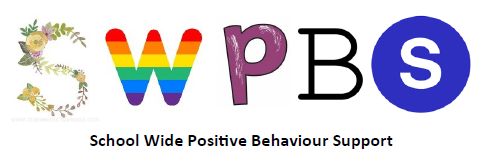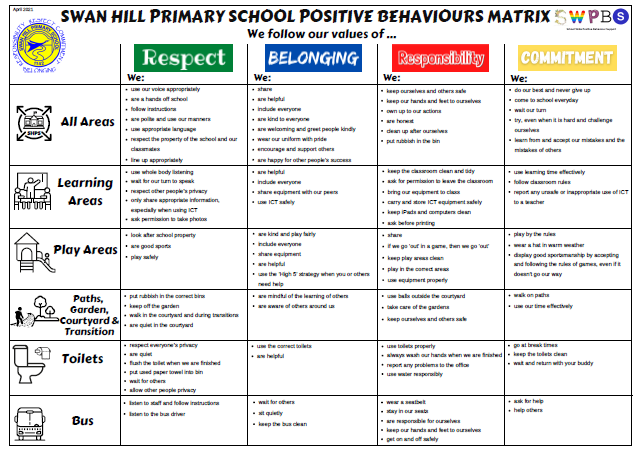
What Is School Wide Positive Behaviour Support? (SWPBS)
School-wide positive behaviour support (SWPBS) is a framework that brings together school communities to develop positive, safe, supportive learning cultures. SWPBS assists schools to improve social, emotional, behavioural and academic outcomes for children and young people.
The goal of School Wide Positive Behaviour Support at SHPS is to create and maintain a positive and safe learning environment that enhances our school culture where we maximise individual academic and social growth.
What Does SWPBS Look Like At Swan Hill Primary School?
- A clear set of behaviour expectations are developed around our key school values (as defined in our matrix).
RESPECT, BELONGING, RESPONSIBILITY, COMMITMENT.
- Our aim is that you can identify the behavioural expectations within 5 minutes of entering the school.
- Students are able to state the behavioural expectations.
- Students are recognised for positive behaviours.
- Positive expectations and behaviours are explicitly taught and encouraged.
- Data will be collected and used for decision making. (Sentral)
- It is a team-based approach.
- Families are actively included.
Behaviour Expectation Matrix
The Behaviour Expectation Matrix translates our school’s four key values (expectations) into expected behaviours. The matrix clarifies what our behaviours should look, sound and feel like. Our expected behaviours are explicitly taught in every classrooms and consistently reinforced throughout the school. Our matrix’s are displayed and positioned in many locations around the school and are referred to and discussed regularly with all students at SHPS. Currently the matrix is in an evolving form, where we are reviewing and refining it. The outcome is to have a complete matrix that we signpost around the school.

Why Do We Explicitly Teach Our Expected Behaviours?
Introducing, modeling and reinforcing positive social behaviour is an important step of a student’s educational experience. Explicitly teaching our behavioural expectations and acknowledging students for demonstrating them is key to our success.
- They are necessary skills for success in life.
- Many students arrive at school without these important skills.
- They are the basis for a positive and safe climate.
- Doing so increases opportunities to teach other skills.
When Do We Teach Our Expected Behaviours?
- At the beginning of school year.
- Often enough to achieve and maintain fluency.
- Before times when problem behaviours tend to increase.
- Ongoing throughout the year. (Refresher lessons)
- At teachable moments.
How Do We Teach Social Behaviours? (SHPS Instructional Model)
I DO:
- Tell – Introduce the expected behaviour and explain why it is important
- Show – Demonstrate and model
WE DO:
- Practice together – Role play expected behaviours in the relevant contexts as a class
YOU DO:
- Independent practice
- Monitor – Pre correct, supervise and provide positive feedback
Multiple exposures are necessary to ensure that skills become automatic.
Reteach as necessary – Practice throughout the day
Where Do We Teach Our Expected Behaviours?
- In every classroom throughout the school.
- Everywhere in the school.
- It is imbedded in other school activities.
Who is on our School Wide Positive Behaviour Support Team?
- Hayley Doyle (Principal)
- Michelle Murphy (Coordinator, Wellbeing Leader)
- Bianca Brasser (Classroom Teacher)
- Mitch Croft (Classroom Teacher)
- Mandy Hinton (Classroom Teacher)
- Nandia Brabham (Classroom Teacher)
- Andrew Cameron (Koorie Education Support)
- Marlene Myers (Education Support)
- Sally Russell (Parent representative)